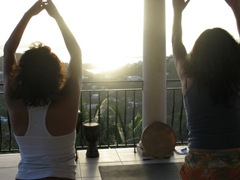 In many cultures, light has long been a symbol of consciousness. Our primary source of light is, of course, the sun. When we look at our closest star we may see a big yellow ball. But for thousands of years, the Hindus have revered the sun, which they call Surya, as both the physical and spiritual centre of our world and the creator of all life. Since everything that exists comes from the sun, Alain DaniŽlou wrote in The Myths and Gods of India (Inner Traditions, 1991), it “must contain the potentiality of all that is to be known.” For the Hindus, the sun is the “eye of the world” seeing and uniting all.
In many cultures, light has long been a symbol of consciousness. Our primary source of light is, of course, the sun. When we look at our closest star we may see a big yellow ball. But for thousands of years, the Hindus have revered the sun, which they call Surya, as both the physical and spiritual centre of our world and the creator of all life. Since everything that exists comes from the sun, Alain DaniŽlou wrote in The Myths and Gods of India (Inner Traditions, 1991), it “must contain the potentiality of all that is to be known.” For the Hindus, the sun is the “eye of the world” seeing and uniting all.
One of the means of honoring the sun is through the asana sequence Surya Namaskar (better known as Sun Salutation). The Sanskrit word namaskar comes from namas, which means “to bow to” or “to adore.” (The familiar phrase we use to close our yoga classes, namaste—te means “you”—also comes from this root.) The yogis taught that each of us replicates the world at large, embodying “rivers, seas, mountains, fields…stars and planets…the sun and moon” (Shiva Samhita, II.1-3). The sun, they asserted, is in reality a token of our own “inner sun.”
It might seem strange that the yogis place the seat of wisdom in the heart, which we typically associate with our emotions, and not the brain. However in yoga, the brain is actually symbolized by the moon, it reflects the sun’s light but generates none of its own. This kind of knowledge is worthwhile for dealing with day to day affairs.
There’s some disagreement over the origins of Sun Salutation. Traditionalists contend that the sequence is at least 2,500 years old (perhaps even several hundred years older) and originated during Vedic times as a ritual to the dawn, replete with mantras, offerings of flowers and rice, and libations of water. Skeptics of this dating maintain that Sun Salutation was invented by the raja of Aundh (a former state in India, now part of Maharashtra state) in the early 20th century and came to the West in the 1920s or 1930s.
However old Sun Salutation is, and whatever it may originally have looked like, lots of variations have evolved over the years.
The eight postures, in order are Tadasana (Mountain Pose), Urdhva Hastasana (Upward Salute), Uttanasana (Standing Forward Bend), Lunge, Plank pose, Chaturanga Dandasana (Four-Limbed Staff Pose), Urdhva Mukha Svanasana (Upward-Facing Dog Pose), and Adho Mukha Svanasana (Downward-Facing Dog Pose).
The transition from posture to posture is linked with either an inhalation or an exhalation. As you move through the sequence, watch your breath. Slow your pace or stop and rest entirely if your breathing becomes labored. Always breathe through your nose : Nasal breathing filters and warms incoming air and slows your breathing down. Thereby lending the sequence a meditative quality.
Launch your practice slowly with three to five rounds, gradually building up to 10 or 15. If this seems like a lot, remember that the traditional number of rounds is 108. You can pace the sequence to generate heat and cleanse the body-mind or slowly to create a moving meditation.
Whatever you do make sure you add a bit of imagination to your sequence and most of all have some fun.









Thanks I have really enjoyed this article
LoL
I’ve subscribed to you blog now, keep this posts up.
I am going to speak to my partner about this
I want to go there